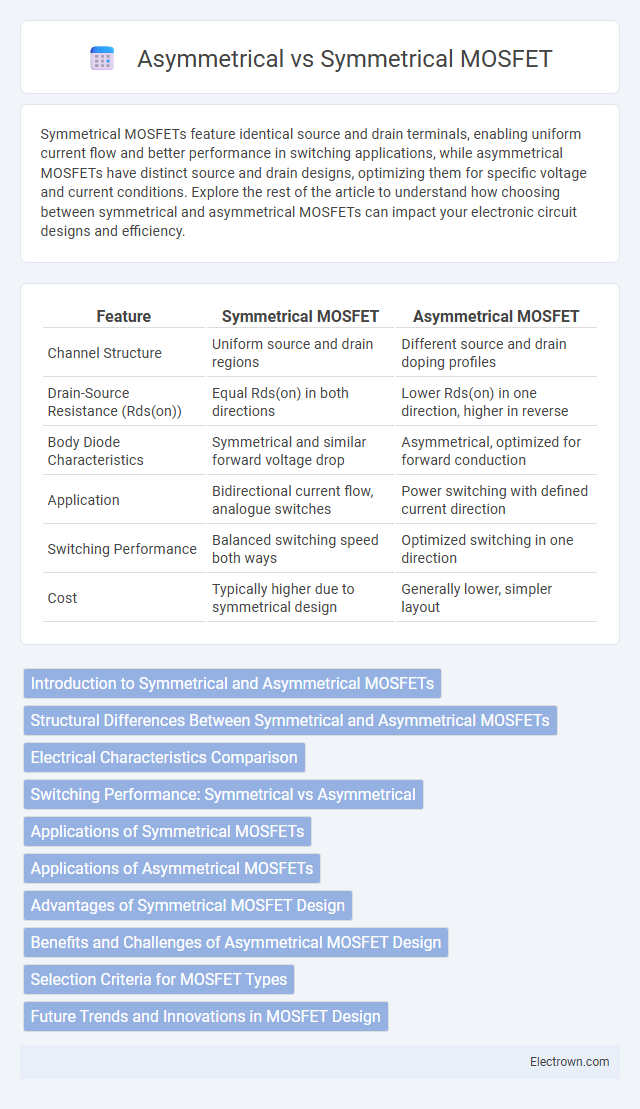Symmetrical MOSFETs feature identical source and drain terminals, enabling uniform current flow and better performance in switching applications, while asymmetrical MOSFETs have distinct source and drain designs, optimizing them for specific voltage and current conditions. Explore the rest of the article to understand how choosing between symmetrical and asymmetrical MOSFETs can impact your electronic circuit designs and efficiency.
Table of Comparison
| Feature | Symmetrical MOSFET | Asymmetrical MOSFET |
|---|---|---|
| Channel Structure | Uniform source and drain regions | Different source and drain doping profiles |
| Drain-Source Resistance (Rds(on)) | Equal Rds(on) in both directions | Lower Rds(on) in one direction, higher in reverse |
| Body Diode Characteristics | Symmetrical and similar forward voltage drop | Asymmetrical, optimized for forward conduction |
| Application | Bidirectional current flow, analogue switches | Power switching with defined current direction |
| Switching Performance | Balanced switching speed both ways | Optimized switching in one direction |
| Cost | Typically higher due to symmetrical design | Generally lower, simpler layout |
Introduction to Symmetrical and Asymmetrical MOSFETs
Symmetrical MOSFETs feature identical source and drain regions, enabling bidirectional current flow with uniform electrical characteristics, enhancing their use in analog switches and AC applications. Asymmetrical MOSFETs have different source and drain designs, optimized for unidirectional current flow, improving performance in digital switching and power efficiency. Understanding these structural differences is essential for selecting the appropriate MOSFET type in electronic circuit design and power management systems.
Structural Differences Between Symmetrical and Asymmetrical MOSFETs
Symmetrical MOSFETs feature identical source and drain structures, allowing current to flow equally well in both directions, which enhances versatility in switching applications. Asymmetrical MOSFETs have distinct source and drain regions with differing doping levels or geometries, optimizing performance for unidirectional current flow but limiting reverse conduction efficiency. The structural differentiation impacts device parameters such as on-resistance, breakdown voltage, and switching speed, with symmetrical designs favoring bidirectional use and asymmetrical types specializing in forward conduction.
Electrical Characteristics Comparison
Symmetrical MOSFETs exhibit identical electrical characteristics for both source-to-drain and drain-to-source current flow, resulting in balanced on-resistance (R_DS(on)) and improved switching performance. Asymmetrical MOSFETs have a directional current path due to an asymmetric channel or doping profile, leading to differing R_DS(on) values and increased body diode conduction losses in the reverse direction. These electrical differences impact efficiency and thermal management in power electronics applications.
Switching Performance: Symmetrical vs Asymmetrical
Symmetrical MOSFETs exhibit balanced switching characteristics due to equal source and drain geometries, resulting in consistent switching speeds and reduced electrical stress during operation. Asymmetrical MOSFETs, with differing source and drain structures, often present faster switching on one direction but may experience higher losses or slower turnaround times in the opposite direction. Optimizing switching performance in power electronics favors symmetrical MOSFETs for uniform switching efficiency, while asymmetrical designs are selectively used for specific directional switching advantages.
Applications of Symmetrical MOSFETs
Symmetrical MOSFETs, characterized by identical performance in both directions, excel in applications requiring bidirectional current flow such as AC switches, load switches, and power management in battery-operated devices. Their balanced structure ensures efficient switching and minimal voltage drop, making them ideal for synchronous rectification in power converters and motor control circuits. You benefit from enhanced reliability and performance in circuits where symmetrical conduction is crucial.
Applications of Asymmetrical MOSFETs
Asymmetrical MOSFETs are predominantly used in power management and switching applications where unidirectional current flow is essential, such as in DC-DC converters and motor control circuits. Their design optimizes performance in low-voltage, high-speed switching scenarios by reducing reverse conduction losses compared to symmetrical MOSFETs. These devices also enhance efficiency and thermal management in battery-operated devices, making them ideal for portable electronics and automotive power systems.
Advantages of Symmetrical MOSFET Design
Symmetrical MOSFET design offers improved switching performance by ensuring consistent electrical characteristics in both directions, leading to reduced on-resistance and lower conduction losses. This design enhances reliability and efficiency in power electronics applications, making it ideal for circuits requiring bidirectional current flow. Your devices benefit from simplified layout design and better thermal management due to the balanced structure of symmetrical MOSFETs.
Benefits and Challenges of Asymmetrical MOSFET Design
Asymmetrical MOSFET design offers benefits such as reduced on-resistance and improved switching speed by optimizing the source and drain regions differently. This approach can enhance device performance in power applications where efficiency and thermal management are critical. However, challenges include increased fabrication complexity and potential variability in threshold voltage, requiring precise process control to ensure consistent device behavior for your circuits.
Selection Criteria for MOSFET Types
Selection criteria for symmetrical versus asymmetrical MOSFETs depend on application requirements such as switching speed, conduction efficiency, and voltage handling. Symmetrical MOSFETs offer balanced performance with identical drain and source structures, ideal for bidirectional current flow and ease of parallel connection. Asymmetrical MOSFETs provide optimized resistance and capacitance characteristics on one side, suitable for high-voltage applications requiring efficient unidirectional conduction and reduced losses.
Future Trends and Innovations in MOSFET Design
Symmetrical MOSFETs offer balanced electrical characteristics and reduced distortion, while asymmetrical MOSFETs provide enhanced performance in specific directional current flow applications. Future trends in MOSFET design emphasize miniaturization, higher power efficiency, and integration of novel materials like GaN and SiC to significantly improve switching speeds and thermal management. Your choice between symmetrical and asymmetrical MOSFETs will increasingly depend on application-specific demands driven by advancements in semiconductor technology and energy efficiency requirements.
Symmetrical vs Asymmetrical MOSFET Infographic

 electrown.com
electrown.com